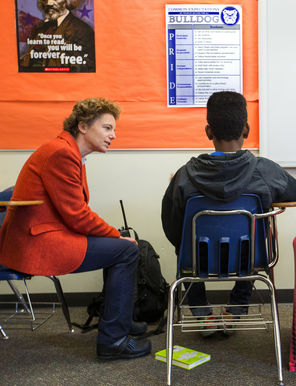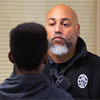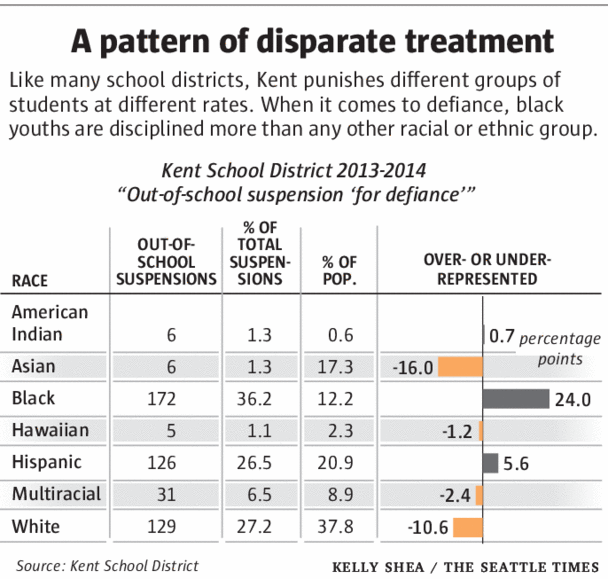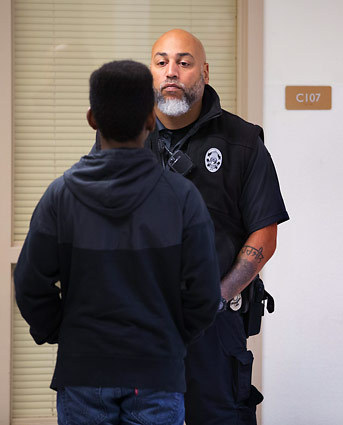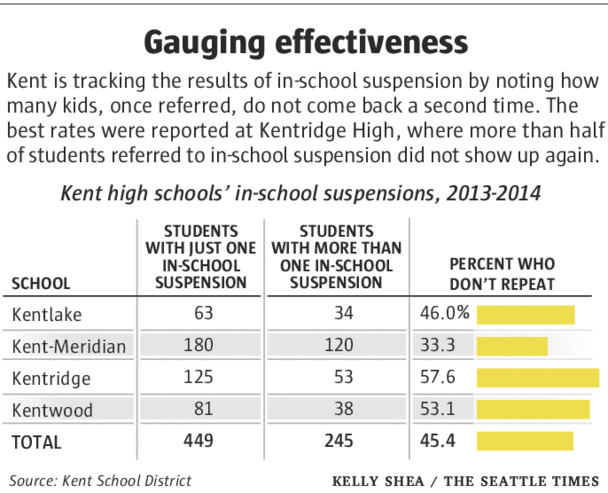Originally published December 5, 2014 at 4:04 PM | Page modified December 8, 2014 at 2:21 PM
Suspending kids doesn’t fix bad behavior; schools look for answers
It stands to reason: Kick troubled students out of school and they often come back even worse. The Kent School District is trying to tackle this national problem by overhauling the way it handles discipline. But its answers spark even more questions.
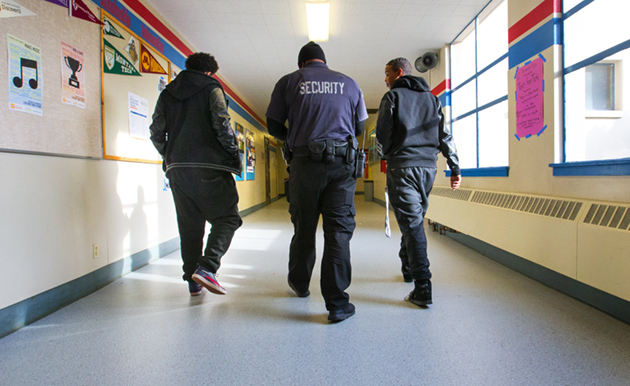
Mike Siegel / The Seattle Times
Ray Jenkins, center, who has worked security at Kent Meridian High School in Kent for eight years, walks the hallway with a few students during a recent school day.
Seattle Times staff reporter
EDITOR’S NOTE
School districts all over the nation are rethinking the way they discipline students, especially for minor infractions. This Education Lab story is the first in an occasional series that will examine why school districts are asking hard questions and what they're doing to answer them.
Today: A look at the Kent School District, which, after a lot of soul-searching, is struggling to balance punishment with ensuring kids finish school.
About the series
Education Lab is a Seattle Times project that spotlights promising approaches to some of the most persistent challenges in public education. It is produced in partnership with the Solutions Journalism Network, a New York-based nonprofit that works to spread the practice of solutions-oriented journalism. Education Lab is funded by a grant from the Bill & Melinda Gates Foundation. Find out more.
Stories in the series
Suspending kids doesn't fix bad behavior; what schools are trying instead
Published December 2014
It stands to reason: Kick troubled students out of school and they often come back even worse. The Kent School District is trying to tackle this national problem by overhauling the way it handles discipline. But its answers spark even more questions. Read the story →
UW gives future engineers a ‘redshirt season’
Published November 2014
In an idea borrowed from college athletics, the University of Washington boosts promising engineering students — many of them women and minorities — with an extra year of academic work. Read the story →
Does class size matter? Research reveals surprises
Published October 2014
The most obvious reason for why smaller classes work — that teachers give students better, more-tailored instruction — probably isn’t the reason why achievement goes up, studies have found. Read the story →
More about Education Lab
![]()
The fight began over a girl. Or online insults. Or because high school is a bubbling caldron of energies that can overflow at any provocation, without regard to rules. And those rules were clear: No violence.
Chris Valmonte learned this the day he was surrounded in the cafeteria at Kentridge High School, threw a punch to ward off his attackers and wound up suspended. Two years later, when his sister was jumped during dismissal, she remembered Chris’ punishment, refused to push back and ended up with a concussion, her budding athletic career dashed.
“What should I do if something like that happens to me?” the Valmontes’ younger brother, David, then an eighth-grader, asked his mother. “What are kids supposed to do if they’re attacked?”
Mary Valmonte did not know how to answer. She brought her son’s question to the Kent School Board. They couldn’t answer, either.
That realization was among the factors behind Kent School District’s difficult journey to confront discipline — not only how to handle students trying to protect themselves, but everyday issues: students who talk back to teachers, defy the rules, fight, disrupt class.
The Valmontes were hardly the only family to complain — Kent schools had been the subject of an NAACP lawsuit for handcuffing and pepper-spraying students not long before — but their case was the final straw.
And while Kent’s discipline policies are still a work in progress, in the three years since Valmonte spoke before the School Board the district has managed to cut suspensions by more than 30 percent.
Instead of the old, zero-tolerance approach, principals now have more discretion to weigh the factors behind kids’ behavior. School-safety officers act as mediators rather than just security guards. And many of the violations that once sent teenagers home for a week, or a month, get addressed through in-school suspension — generally, a drab classroom where students spend entire days reflecting on their poor choices and, in theory, keeping up with classwork.
Complex issue
To varying degrees, and for varying reasons, many Washington school districts are engaged in similar efforts because, to put it plainly, suspending kids doesn’t work.
A growing mountain of national data suggests that punitive discipline that removes kids from school leads to lower graduation rates. No surprise. Students who mouth off to teachers, or fight, or cut class are typically the least engaged in classwork. Sending them home without any sort of tutoring or oversight guarantees that they will be further behind upon return, which means discipline aimed at punishment actually appears to push kids toward failure, even for minor offenses.
“It’s just common sense — if kids aren’t in school, they’re not learning and we’re putting them at greater risk,” said Chris Loftis, a spokesman for Kent schools.
A Texas study found that 31 percent of suspended students repeat a grade; 10 percent ultimately drop out.
Last year, the children’s advocacy group Washington Appleseed said in a report that every seat in Safeco Field could be filled with Washington students suspended or expelled from public schools during 2009-10. The vast majority were not disciplined for anything directly imperiling safety, like carrying a weapon, but minor offenses, such as refusing to remove a hat.
“In all honesty, almost everything in discipline is quite subjective,” said Kate Mosehauer, author of the report. “Often, it’s not anything that relates to safety. That’s what we’re seeing for the first time — nearly 50,000 kids being excluded from school for things like having a cellphone in class. That’s what’s really shocking.”
These numbers, however, are merely the tip of a very jagged iceberg. The question of how to handle discipline touches every hot button in education: race; societal forces outside the classroom; and the autonomy of teachers.
Seemingly obvious remedies — like keeping kids connected to academics with in-school suspensions — may shine up the statistics, but don’t necessarily create an improved atmosphere. Teachers say they are in an impossible bind: held accountable for improving student test scores, while increasingly discouraged from sending disruptive kids out of the classroom.
“Sure, our numbers look great,” said Sue McCabe, president of the teachers union in Highline Public Schools, which, like the Kent and Federal Way school districts, is moving away from removing students. “But is behavior better? No, it’s worse. We’ve got kids saying ‘There are no suspensions anymore so we can do whatever we want.’ We’re in a pressure-cooker, and it’s boiling.”
‘Deserve an education’
In Washington, these difficulties are compounded by the fact that students of different races tend to be disciplined differently — for the same offense.
Kent is no exception. More than one-third of the 475 youths suspended for “defiance” last school year were black, though African Americans comprise only 12 percent of the district’s student population. By contrast, white students written up for “defiance” were more often given a warning with no loss of class time.
Seattle Public Schools has been under federal investigation for similar disparities since 2012.
“Behavior is a diversity issue — kids from some groups behave differently than others,” said Loftis, the Kent spokesman. “But every one of them deserves an education, instead of being pushed out and told ‘You don’t conform.’ ”
Part of the problem stems from a lack of data. Historically, schools had to report only a narrow range of serious incidents involving drugs, weapons or violence — the ones nearly everyone agrees should result in a student’s removal from school.
Yet of the 72,230 suspensions and expulsions recorded statewide during 2012-13, more than 52 percent were for a category called “other” in which black students are overrepresented, more than any other race or ethnic group.
“This is where we see discipline for ‘defiance’ or ‘disobedience,’ and this is also where the discretion of educators comes into play,” said Tim Stensager, director of data governance at the Washington state Office of Superintendent of Public Instruction. “It makes us wonder, exactly what is it that they’re really being kicked out for?”
Frankly troubled by such questions, Stensager has spent months presenting this information to educators and lawmakers. Olympia has taken notice. This past Tuesday, members of the House Education Committee were visiting with students in Kent schools, trying to gather their own impressions.
Inconsistency in the crime-punishment equation — open to interpretation by whichever administrator may be meting out sanctions — undoubtedly contributes to the problem. In some places, a student suspected of smoking marijuana might get a stern warning and a counseling session. In Kent, such an infraction used to mean the most stringent punishment short of expulsion — up to 40 days out of school, the equivalent of two months’ instruction.
“You don’t come back from that,” Ray Jenkins, a school-safety officer at Kent-Meridian High, said while escorting a baby-faced class-cutter suspected of smoking pot toward the in-school suspension room.
“This is not supposed to be fun,” said Yvonne Ulrich-Pierce, who oversees the program. “The most important thing to me is that students not like this place.”
Discipline disparities
In-school suspension became Kent’s preferred answer for high-school kids in the wake of Mary Valmonte’s question to the School Board. After that awkward moment, the district convened a committee of teachers, administrators, children’s advocates and community members who buried themselves in discipline data and legalese.
“This was long overdue,” said School Board member Maya Vengadasalam.
The committee met each month for a year, and by many accounts it was an ugly process. Tempers flared. Sessions scheduled to last 60 minutes often stretched to an emotional three hours. Some members were furious that the school district, with its long history of racial friction, shied from tackling discipline disparities between black and white students.
“The same problems that existed 25 years ago exist today,” said Mel Tate, who is African American and once served as the district’s ombudsman on discipline. “Why are we still fighting this battle?”
In response, Kent has begun to collect detailed information on exactly who is being punished, for what, and at which schools.
“The objective here is not to vilify or pass any judgments,” said Vengadasalam, who hopes that data will lead, ultimately, to better training. “We’re not out to get the teachers.”
Yet classroom educators are among those most frustrated by shifting discipline policies.
The lead teacher on Kent’s discipline committee declined to discuss its process, or results, though last summer the union filed a grievance against Mill Creek Middle School, claiming that students were “widely known to be out of hand.”
Mill Creek has two new assistant principals, brought in primarily to help with behavior, and on a recent Wednesday morning the so-called “Focus Room” for in-school suspensions was quiet.
“It’s just common sense —
if kids aren’t in school, they’re not learning and we’re putting them at greater risk.”
- Chris Loftis, spokesman for the
Kent School District
Four students sat there. One for talking to a girl during English. Two others for verbal sparring. The last for showing up late to a college-preparation session — and then skipping the detention that resulted.
“Ever since the new principals came it’s gotten a lot harder,” the chronically truant boy said. “I’ve been in here at least 15 times this year.”
His remark speaks to a core challenge with in-school suspension: Corralling kids in a de facto study hall may be better than sending them home, but it hardly constitutes a rigorous academic experience.
The truant eighth-grader said his best grade this year is a C, in history. The rest are Ds and Fs.
“Sure, in-school suspension is a step in the right direction,” said Kristina McCormick, who graduated from Kentridge and recalls watching 47 of her schoolmates suspended en masse for watching a fight.
“But it’s also telling students who are having trouble, ‘OK, here’s your work. Be self-directed and do it.’ People have the perception that it’s going to be continued learning time, and I’m not sure that’s the case.”
McCormick eventually became a teacher and worked for two years in Kent before quitting in June out of frustration.
Too enjoyable?
At Mill Creek Middle School, the Focus Room is managed by an aide, not a teacher. But even at the secondary level, where Kent does use teachers to oversee the in-school suspension program, many educators remain unsatisfied.
Jay Maebori, who teaches English at Kentwood High, said part of his concern is that students appear to like in-school suspension a little too much.
At Kentwood, that is largely due to the presence of John Bush, 40, a onetime basketball prospect at Seattle University who has become such a comforting figure that many students would rather remain in his portable classroom than return to the rush of activity in the main building. Even after their punishment ends, some come by during lunch just to escape the noise and chaos of the cafeteria.
Ninth-grader Brianna Miles, who calls herself a “reformed bad girl,” arrives every day at fourth period. Robert Lord, 19, who was briefly expelled after fighting, spent most of this fall in Bush’s room, finishing up algebra and history credits so he can graduate this month.
“The concept is good,” Maebori said. But still, he said, “If they’re going to go some place, it should be unpleasant for them to be there. It needs to be a place of holding kids accountable. I want them to come back changed.”
When he ponders the problem, Maebori, state Teacher of the Year in 2011, keeps returning to his memory of a transformative moment early in his career. A former principal had gathered several boys in the Kentwood library — all of them chronic troublemakers, all African American — and asked why they were so reluctant to do schoolwork, why they were always in trouble.
“They were very honest,” Maebori recalled, “They talked about teachers giving them the sense that they couldn’t achieve, that we had given up on them.”
For Maebori, it was the proverbial ‘aha’ moment. How often, he wondered, had he inadvertently conveyed this message?
“I wish we did more of that, sit down with kids and give them some voice,” he said. “That is the step I think is missing now.”
“In the past, it was either suspend or expel. But if they’re going to go some place, it should be unpleasant for them to be there. It needs to be a place of holding kids accountable. I want them to come back changed.”
- Jay Maebori, English teacher at Kentwood High School
Traces of that long-ago lesson are showing up again in the figure of Jenkins, the school-safety officer at Kent-Meridian. For seven hours a day, he patrols class-cutting hot spots and school hallways, rattling off a capsule life-story of each student who crosses his path — the boy who collects sneakers, the girl who sleeps on a friend’s couch, the youth who did time in a juvenile lockup and is now headed for college.
“Code Red!” crackles the voice on his walkie-talkie. Suddenly, Jenkins is bounding toward the cafeteria, where one student is backed against the wall, another’s salad dashed to the floor and dozens more stand braced for a fight, jittery with anticipation. Two years ago, a flare-up like this would have resulted in suspensions for all of them.
Instead, the two sophomores at the center, a boy and girl who had been friends in middle school, soon found themselves in Jenkins’ office, working through their differences as if in marriage counseling.
“You say your piece,” the barrel-chested former Marine told the young man, while motioning for the girl to keep quiet.
“Now you,” the officer nodded at her.
A tale emerged of whispers and cliques, outgrown friendships and shifting alliances. Within 15 minutes the tension had dissipated, and all that remained were two kids who wanted nothing so much as to return to routine.
The girl sat, eating a new salad assembled by Jenkins, who had quietly tucked a sweet roll on the side.
“You ready to go back to class now?” he said.
Seattle Times reporter Justin Mayo contributed to this report.
Claudia Rowe: crowe@seattletimes.com or 206-464-2531. On Twitter @RoweReport
 Four weeks for 99 cents of unlimited digital access to The Seattle Times. Try it now!
Four weeks for 99 cents of unlimited digital access to The Seattle Times. Try it now!










